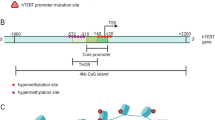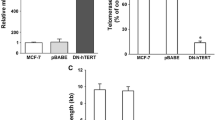Abstract
Recently, telomerase-targeted therapy was studied intensively; however, many studies have verified the existence of alternative lengthening mechanisms of telomeres in vitro. In the present work, we explored the expression characteristic of the two kinds of telomere-prolonging mechanisms in the breast cancer tissues per se. Furthermore, we studied the relationship between Her-2 expression and ALT pathway. Ninety samples of breast cancer tissues were examined in this research. RT-PCR was used for the detection of the expression of human telomerase reverse transcriptase (hTERT); IHC was used for the detection of the expression of promyelocytic leukemia body (PML) bodies; the co-expression of PML bodies and hTERT was detected using the QDs-based immunofluorescence. The co-expression of PML body and hTERT was found in the same cell in breast cancer tissues, and ten samples expressed neither PML bodies nor hTERT. Additionally, the expression of PML bodies and Her-2 was statistically co-related (P = 0.047). The two kinds of mechanisms of telomere extension can co-exist in the same cell in beast cancer tissues, and there may be other mechanisms of telomere extension functioning in human breast carcinoma.


Similar content being viewed by others
References
Chen W-q, Zheng R-s, Zeng H-m, Zhang S-w, Li G-l, Wu L-y, et al. Incidence and mortality of breast cancer in China, 2008. Thorac Cancer. 2013;4:59–65.
Zeng H, Zheng R, Zhang S, Zou X, Chen W. Incidence and mortality of female breast cancer in China, 2009. Thoracic Cancer. 2013;4:400–4.
Shay JW, Bacchetti S. A survey of telomerase activity in human cancer. Eur J Cancer. 1997;33:787–91.
Reddel RR, Bryan TM, Colgin LM, Perrem KT, Yeager TR. Alternative lengthening of telomeres in human cells. Radiat Res. 2001;155:194–200.
Cerone MA, Londono-Vallejo JA, Bacchetti S. Telomere maintenance by telomerase and by recombination can coexist in human cells. Hum Mol Genet. 2001;10:1945–52.
Fan Y, Yao Y, Li L, Wu Z, Xu F, Hou M, et al. Nm23-h1 gene driven by htert promoter induces inhibition of invasive phenotype and metastasis of lung cancer xenograft in mice. Thoracic Cancer. 2013;4:41–52.
Blackburn EH. Switching and signaling at the telomere. Cell. 2001;106:661–73.
Rubin H. The disparity between human cell senescence in vitro and lifelong replication in vivo. Nat Biotechnol. 2002;20:675–81.
Gehmert S, Gehmert S, Prantl L, Vykoukal J, Alt E, Song YH. Breast cancer cells attract the migration of adipose tissue-derived stem cells via the pdgf-bb/pdgfr-beta signaling pathway. Biochem Biophys Res Commun. 2010;398:601–5.
Hayflick L. The establishment of a line (wish) of human amnion cells in continuous cultivation. Exp Cell Res. 1961;23:14–20.
Holt SE, Shay JW. Role of telomerase in cellular proliferation and cancer. J Cell Physiol. 1999;180:10–8.
Henson JD, Hannay JA, McCarthy SW, Royds JA, Yeager TR, Robinson RA, et al. A robust assay for alternative lengthening of telomeres in tumors shows the significance of alternative lengthening of telomeres in sarcomas and astrocytomas. Clin Cancer Res :Off J Am Assoc Cancer Res. 2005;11:217–25.
Mukhopadhyay D, Matunis MJ. Summoning daxx-mediated repression. Mol Cell. 2011;42:4–5.
Lallemand-Breitenbach V, de The H. Pml nuclear bodies. Cold Spring Harbor Perspectives in Biology. 2010;2:a000661.
Draskovic I, Arnoult N, Steiner V, Bacchetti S, Lomonte P, Londono-Vallejo A. Probing pml body function in alt cells reveals spatiotemporal requirements for telomere recombination. Proc Natl Acad Sci U S A. 2009;106:15726–31.
Brouwer AK, Schimmel J, Wiegant JC, Vertegaal AC, Tanke HJ, Dirks RW. Telomeric DNA mediates de novo pml body formation. Mol Biol Cell. 2009;20:4804–15.
Grobelny JV, Kulp-McEliece M, Broccoli D. Effects of reconstitution of telomerase activity on telomere maintenance by the alternative lengthening of telomeres (alt) pathway. Hum Mol Genet. 2001;10:1953–61.
Maringele L, Lydall D. Telomerase- and recombination-independent immortalization of budding yeast. Genes Dev. 2004;18:2663–75.
Grandin N, Charbonneau M. Telomerase- and rad52-independent immortalization of budding yeast by an inherited-long-telomere pathway of telomeric repeat amplification. Mol Cell Biol. 2009;29:965–85.
Subhawong AP, Heaphy CM, Argani P, Konishi Y, Kouprina N, Nassar H, et al. The alternative lengthening of telomeres phenotype in breast carcinoma is associated with her-2 overexpression. Mod Pathol Off J US Can Acad Pathol Inc. 2009;22:1423–31.
Acknowledgements
This work was supported in part by the National Nature Science Foundation (No.81102024 and No.81372407) and the Nature Science Foundation of Hubei Province (No.2013CFB234).
Conflicts of interest
The authors declare that they have no conflict of interest.
Author information
Authors and Affiliations
Corresponding author
Additional information
Bin Xu and Min Peng contributed equally to this work.
Rights and permissions
About this article
Cite this article
Xu, B., Peng, M. & Song, Q. The co-expression of telomerase and ALT pathway in human breast cancer tissues. Tumor Biol. 35, 4087–4093 (2014). https://doi.org/10.1007/s13277-013-1534-0
Received:
Accepted:
Published:
Issue Date:
DOI: https://doi.org/10.1007/s13277-013-1534-0




